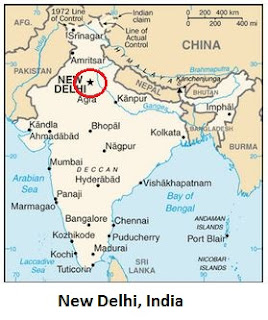#11,835
Three days ago, in India: New Delhi Zoological Park Closed Due To Suspected H5N1, we looked at the initial reports of a die-off of birds at a 176 acre park which lies in the heart of that nation's capital.
Overnight, the National Institute for High Security Animal Diseases (NIHSAD) in Bhopal reportedly announced that the subtype has now been identified as H5N8, not H5N1.
Local officials and the media are treating this as relatively `good' news - since H5N8 has yet to be found to infect humans - but the arrival of a new (to India) strain of bird flu is not without some potentially serious consequences.
First, the H5N8 virus is continually mutating, and easily reassorts with other subtypes, meaning its current inability to infect humans may not last forever.
The H5N8 virus belongs to the same H5 clade 2.3.4.4. as two subtypes (H5N1 & H5N6) which can infect, and sometimes kill, humans.
Secondly, H5N8 has proven to be an exceptionally good traveler, hitchhiking its way on migratory and wild birds, and able to cover vast distances in a short period of time.
Our last H5N8 sighting outside of China (see FAO/EMPRES: H5N8 Clade 2.3.4.4 Detected Over Summer In Russia) was around Ubsu-Nur lake, some 2,800 km north and east of New Delhi.
In the wake of the Russian detection, last August the FAO warned:
Countries and places in Central Asia, the Caucasus, the Middle East, Europe and West Africa – especially those that have experienced outbreaks in 2005/06, 2009/10 and/or 2014/15 (as shown in Maps 2, 3 and 4) – should be on alert over the next 6 to 12 months, as westward and southern spread of the H5N8 virus is likely. If the virus enters Egypt or West Africa, where H5N1 HPAI viruses are already present or even entrenched in poultry populations it would further complicate disease control.
South Asia may also be at risk of incursion of this H5N8 HPAI clade 2.3.4.4 virus, potentially arriving there with fall migration in 2016.
Almost on cue, the H5N8 virus has now shown up in South Asia, and it has the potential to move further down the Indian subcontinent as migratory birds continue their way south.
Although there are two annual bird migrations (spring and fall) to worry about, a recent report (see Sci Repts.: Southward Autumn Migration Of Waterfowl Facilitates Transmission Of HPAI H5N1) pegs the fall migration as the biggest risk for the spread of HPAI by migratory birds.
While not unexpected, the discovery of H5N8 in India also raises concerns over where else the virus may appear this winter.
As the DEFRA graphic below illustrates, the migratory flyways that brought the virus to India could also deliver the virus to the Middle East, Africa, and Europe.
The arrival of H5N8 to North America, Taiwan, and Korea has wreaked havoc oin their poultry industries, and in the spring of 2015 sparked the largest epizootic in North America's history.
Just as H5N8 appears to be following the expansionist footsteps we saw H5N1 undertake a decade ago, there are at least two other avian viruses circulating widely in China that could someday follow suit; H7N9 and H5N6.
Unlike H5N8, these two recently emerged viruses can infect humans as well as poultry, and if they were to spread, could conceivably cause even more harm.
For more on the threat of migratory birds spreading avian flu, you may wish to revisit a blog from earlier this month called:
Migratory Birds & The Spread Of Highly Pathogenic Avian Flu

